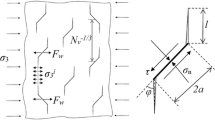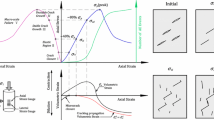Abstract
This paper is concerned with theoretical and experimental estimations of fracture-load degradation due to an increase of damage within a rock. The physical interpretation of this increase will involve a change in length of the process zone and a reduction in modulus. A linear cohesive-zone model of the type introduced by Dugdale and Barenblatt is formulated for large-scale yielding in a geometric sense to demonstrate the effect of microcracking on the critical load of a stationary crack. Experiments with a limestone in the chevron-notched, round beam geometry are conducted at elevated temperatures up to 150°C to evaluate the fracture load as a function of damage. When a material such as rock is heated slowly and uniformly, intergranular thermal stresses develop independent from a temperature gradient because of the local nonhomogeneity or anisotropy of the matrix. With the assumption of brittle behavior, thermal microcracking is shown to contribute to the degradation of the fracture load, as measured by the toughness, mainly through a reduction in modulus. Preliminary results indicate, however, that the energy dissipated in fracturing the damaged rock actually increases.
Similar content being viewed by others
References
J.B. Walsh, Journal of Geophysical Research 70 (1965) 381–389.
T.T. Wu, International Journal of Solids and Structures 2 (1966) 1–8.
H. Spetzler, E. Schreiber and R.J. O'Connell, Journal of Geophysical Research 72 (1972) 4938–4944.
B. Budiansky and R.J. O'Connell, International Journal of Solids and Structures 12 (1976) 81–97.
F.S. Henyey and N. Pomphrey, Geophysical Research Letters 9 (1982) 903–906.
R.W. Zimmerman, International Journal of Rock Mechanics and Mining Sciences & Geomechanics Abstracts 21 (1984) 339–343.
Y. Fu and A.G. Evans, Acta Metallurgica 33 (1985) 1515–1523.
R.M. McMeeking and A.G. Evans, Journal of the American Ceramic Society 65 (1982) 242–251.
A.G. Evans and Y. Fu, Acta Metallurgica 33 (1985) 1525–1531.
J.W. Hutchinson, Acta Metallurgica 35 (1987) 1605–1619.
M.G. Jenkins, A.S. Kobayashi, K.W. White and R.C. Bradt, Journal of the American Ceramic Society 70 (1987) 393–395.
M. Ortiz, Journal of Applied Mechanics 54 (1987) 54–58.
M. Ortiz, International Journal of Solids and Structures 24 (1988) 231–250.
A. Chudnovsky and M. Kachanov, International Journal of Engineering Science 21 (1983) 1009–1018.
M. Kachanov and E. Montagut, Engineering Fracture Mechanics 25 (1986) 625–636.
M. Hori and S. Nemat-Nasser, Journal of the Mechanics and Physics of Solids 35 (1987) 601–629.
R. Ballarini and M. Denda, International Journal of Fracture 37 (1988) 61–71.
A.G. Evans, Scripta Metallurgica 10 (1976) 93–97.
R.A. Schmidt, Proceedings of the 21st U.S. Symposium on Rock Mechanics, Rolla, Missouri (1980) 581–590.
D.S. Dugdale, Journal of the Mechanics and Physics of Solids 8 (1960) 100–104.
G.I. Barenblatt, Advances in Applied Mechanics 7 (1962) 55–129.
C.C. Wu, S.W. Freiman, R.W. Rice and J.J. Mecholsky, Journal of Materials Science 13 (1978) 2659–2670.
R.W. Rice, S.W. Freiman and P.F. Becher, Journal of the American Ceramic Society 64 (1981) 345–350.
P.L. Swanson, Journal of Geophysical Research 92 (1987) 8015–8036.
J.F. Labuz, S.P. Shah and C.H. Dowding, Journal of Engineering Mechanics 115 (1989) 1935–1949.
J.F. Labuz, S.P. Shah and C.H. Dowding, International Journal of Rock Mechanics and Mining Sciences & Geomechanics Abstracts 22 (1985) 85–98.
J. Janson, Engineering Fracture Mechanics 9 (1977) 891–899.
F. Ouchterlony, Fracture Mechanics Methods for Ceramics, Rocks, and Concrete, ASTM STP 745, S.W. Freiman and E.R. Fuller (eds.), (1981) 237–256.
A.J. Bush, Experimental Mechanics 16 (1976) 249–257.
L.M. Barker, Engineering Fracture Mechanics 9 (1977) 361–369.
F. Ouchterlony, International Journal of Rock Mechanics and Mining Sciences & Geomechanics Abstracts 25 (1988) 71–96.
L.M. Barker, International Journal of Fracture 15 (1979) 515–536.
F.E. Buresch, Fracture Mechanics of Ceramics 4, R.C. Bradt, D.P.H. Hasselman and F.F. Lange (eds.), Plenum Press, New York (1978) 835–847.
L.M. Barker, K Ic Measurements Using Short Rod Specimens — The Elastic-Plastic Case. Terra Tek Report 77-91R, Salt Lake City, Utah (1977).
Author information
Authors and Affiliations
Rights and permissions
About this article
Cite this article
Labuz, J.F., Chen, C.N. & Berger, D.J. Microcrack-dependent fracture of damaged rock. Int J Fract 51, 231–240 (1991). https://doi.org/10.1007/BF00045809
Received:
Accepted:
Issue Date:
DOI: https://doi.org/10.1007/BF00045809




